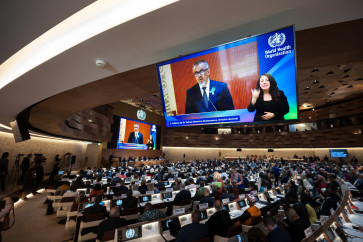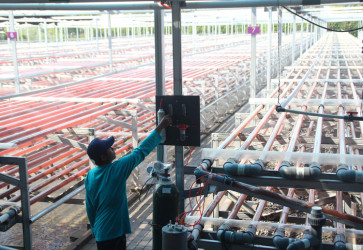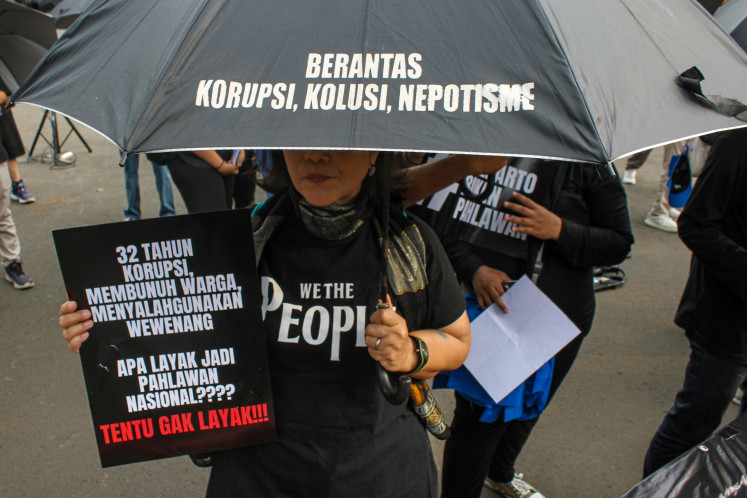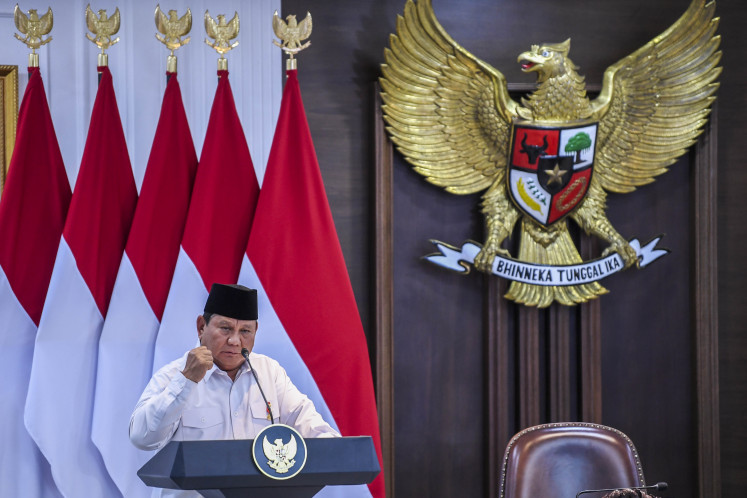Icad 2015: Vertical Horizon Explores time & space boundaries
Green pieces: Visitors view rattan works by emerging Danish designers on display at the Indonesian Contemporary Art and Design (ICAD) showcase, which runs until Nov
Change text size
Gift Premium Articles
to Anyone
 Green pieces: Visitors view rattan works by emerging Danish designers on display at the Indonesian Contemporary Art and Design (ICAD) showcase, which runs until Nov. 30 at the Grandkemang Hotel in Kemang, South Jakarta.(Courtesy of ICAD) (ICAD) showcase, which runs until Nov. 30 at the Grandkemang Hotel in Kemang, South Jakarta.(Courtesy of ICAD)
Green pieces: Visitors view rattan works by emerging Danish designers on display at the Indonesian Contemporary Art and Design (ICAD) showcase, which runs until Nov. 30 at the Grandkemang Hotel in Kemang, South Jakarta.(Courtesy of ICAD) (ICAD) showcase, which runs until Nov. 30 at the Grandkemang Hotel in Kemang, South Jakarta.(Courtesy of ICAD)
G
span class="caption">Green pieces: Visitors view rattan works by emerging Danish designers on display at the Indonesian Contemporary Art and Design (ICAD) showcase, which runs until Nov. 30 at the Grandkemang Hotel in Kemang, South Jakarta.(Courtesy of ICAD)
What is vertical horizon? Two lines that meet at one point or a representation of human and divine worlds.
Painters, sculptors, designers and, surprisingly a high-ranking official, shared their own definitions of vertical horizon, the core theme of the Indonesian Contemporary Art and Design (ICAD) showcase this year.
Running from Oct. 28 until Nov. 30, the showcase's artwork brings a different vibe to the lobby, stairwell and corners of grandkemang hotel Jakarta in the upscale area of Kemang, South Jakarta.
'Vertical horizon is how we see visually and philosophically,' curator Hafiz Rancajale said on the opening day.
'In Islam, for instance, we know habluminannas, the relationship between humans, is associated with a vertical line, while habluminallah, the relationship of a human with God, with a horizontal line.
'In here, we can see designers and artists offering their individual perspectives on vertical horizon.'
On the walls of the hotel's lobby, there are four white robes embellished with black ink strokes of dotted lines and feet. The work, titled 'Besar' (Big), is the observation of Dutch artist and cofounder of the Cemeti Art House Gallery, Mella Jaarsma, on death and life after death.
Some works, perhaps, tickle the spines of hotel visitors. Not far from the white robes, there are pairs of legs dangling from the ceiling. If you are curious enough, you can go to the second floor and find the other half of the bodies, in the form of life-sized dolls in bikinis.

Through the installation titled I Need a Room with a View of My Room, Marishka Soekarna offers the perspective of an antisocial individual.
The Secret Agents, a piece by photographers Indra Ameng and Keke Tumbuan, installed a vintage telephone in the lobby with a note: 'We provide a telephone as a hotline service to connect with a room on the top floor of this hotel.'
'If lucky, someone will answer your call directly. But if not, please leave a message after the tone,' the note reads.
Awan Simatupang's sculpture of a head painted with bright colors and patterns welcomes visitors at the hotel entrance. Titled Luka, the sculpture describes the conversion of pain into joy and vice versa.
Entering its sixth year, ICAD remains committed to being a meeting point of design, art and the hotel industry. ICAD artistic director Harry Purwanto expects the event to drive the public's interest toward Indonesian contemporary art and design.
'We want to inspire people who are not familiar with Indonesian contemporary art. The exhibition is our way of bringing fresh knowledge to them,' Harry said.
Some artists bring colors and tunes to the hotel space. Ines Katamso created Box of Horizon, an installation of rows of threads in rainbow colors attached inside a 4 square-meter room.
Making its debut at the exhibition, Creative Economy Agency head and former musician Triawan Munaf combines two piano keyboards in an interactive found object work titled 'vi-cis-si-tude'. The instrument drives visitors' attention, mainly on account of its unexpected tones and sound effects that it produces.
'Art and design hold different paradigms. Design is more into practicality, while contemporary art emphasizes context. ICAD plays an important role in marrying the two,' Hafiz said.
The perfect sample is The Last Room (Availability), a collaborative work of sound artist Bagus Pandega, videographer Alain Goenawan, Nidji keyboardist Randy Danistha and interior designer Diana Nazir.
It blends music, kinetic art and video art in a setting of a hotel room, which Diana decorated with Danish products, such as those from Lego, Lindberg eyewear and furniture company Republic of Fritz Hansen.
'The music describes a person relentlessly waiting to hear whether they have gotten the last room in a hotel or not. I insert the sound of a hammer and ticking clock to it,' Randy said.

Diana, who is also ICAD festival director, said the presence of Danish products was part of ICAD's cooperation with Denmark. Additionally, ICAD is also exhibiting the rattan projects of 14 Danish design and architecture students who created the artworks during their residency in Cirebon, West Java.
Diana created an initial exhibition to welcome the queen of Denmark, Margrethe II, during her recent visit to Jakarta.
'Due to her age, we were requested to keep the event only 30 minutes. But when it ended, the queen said she wanted to see more, so we showed her more artworks for another 15 minutes,' Diana said.
Aside from the exhibition, in the coming weeks ICAD will hold three conventions on art, film and batik design in cooperation with the Indonesian Art Coalition (KSI), Motion Pictures Association (MPA) and the Association of Indonesian Film Producers (APROFI).









